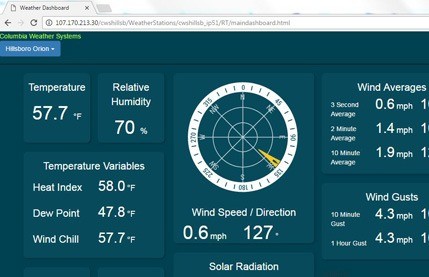Cloud-based Weather Server Coming Soon!
Thinking ahead to New Year Resolutions, Columbia Weather Systems is in the process of implementing the first phase of our cloud-based Weather Server, available with any of our weather stations through the Weather MicroServer device. Current weather data can be automatically uploaded from the weather station to the cloud Weather Server on a 5 second interval.
Customers will be able to view the real-time Display Screen using a browser from anywhere on the Internet. WeatherMaster software will be able to connect to the cloud to monitor and store the data from a remote weather station.
The Weather Server is a solution for customers that are unable to upload data (via FTP) to their website or implement port forwarding for the MicroServer in order to access it directly from outside the network. Both of these options are often not available due to limited access to corporate websites and increased security restrictions.
The Weather Server will offer an automatic way to view the weather data on the web without the hassle of designing your own web page.
The Display Screen on the Weather Server is designed specifically for our weather stations.
The second phase of the project will add historical data and trend graphs.
Customers will be able to view the real-time Display Screen using a browser from anywhere on the Internet. WeatherMaster software will be able to connect to the cloud to monitor and store the data from a remote weather station.
The Weather Server is a solution for customers that are unable to upload data (via FTP) to their website or implement port forwarding for the MicroServer in order to access it directly from outside the network. Both of these options are often not available due to limited access to corporate websites and increased security restrictions.
The Weather Server will offer an automatic way to view the weather data on the web without the hassle of designing your own web page.
The Display Screen on the Weather Server is designed specifically for our weather stations.
The second phase of the project will add historical data and trend graphs.




Comments
Post a Comment